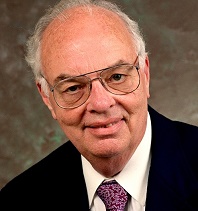
Leroy Thomas Kerth
Professor of Physics, Emeritus
Leroy T. “Roy” Kerth, a remarkably talented teacher, administrator, and experimental physicist who was deeply devoted to the University of California, died in his sleep on November 7, 2016, at age 87.
As a dedicated full-time teacher, Kerth exuded a love for classical physics, especially for devising ever-more-elegant solutions to the challenging electrodynamics problems posed by his friend J.D. Jackson. Also, serving as vice chair for instruction, he brought the Physics Department’s course-grade, teaching-assignment, and teaching-evaluation records into the era of personal computing. Another facet of Kerth’s teaching was his concern for Ph.D. students and other younger colleagues. He supported them faithfully, hosted them regularly at home with his wife Ruth, and delegated to them all the responsibility they could handle. Students working with Kerth’s research group at Lawrence Berkeley Lab went on to leading positions on distinguished physics faculties across three continents.
As a broadly gifted administrator, Kerth served as associate dean of the College of Letters & Science in the aftermath of the Free Speech Movement. Much later, between 1983 and 1988, he fully reorganized the Berkeley Lab’s computing division as its new head. Thereafter he served as associate Berkeley Lab director both for General Sciences (1988-91) and for Scientific and Technical Resources (1991-93). Kerth also advised Fermilab’s director on its scientific program.
Kerth, who was born on November 23, 1928 in Visalia, California, and grew up on a small California farm, earned a bachelor’s degree in science from UC Berkeley in 1950. Excited to join the UC Radiation Laboratory during its golden era, he obtained his Ph.D. in 1957 under E.M. McMillan by completing one of the first measurements at that laboratory’s new Bevatron accelerator. Experiments in which he was involved at the Berkeley, Fermilab, and SLAC national laboratories included the first observations of the top quark, of charmed particles produced by muons, and of direct charge-parity-symmetry violation.
Starting even before the launch of the Apple I personal computer, Kerth developed a lifelong interest in computing. Initially, he arduously programmed primitive devices to control apparatus in real time. Later this interest grew in many directions, ranging from computing administration to recordkeeping and demonstrations for teaching.
In all of this work, Kerth maintained a highly innovative, hands-on style. For example, he led the development in the 1960s of one of the first automatic film scanners for particle physics, and in the 1990s he devised an ingenious mechanism for splitting the Silicon Vertex Tracker used in the BaBar experiment at SLAC so it could be installed around the beam pipe. Throughout his career, he worked tirelessly to ensure the success of many experiments, even fashioning scale models in his home workshop.
Additional insights into Kerth’s character are gained from an accomplishment at the start of his career and from an anecdote near its end. Documented in a 1955 National Archive photo and in his 1957 Ph.D. thesis is his quadrupole-magnet arrangement that focused a secondary beam of K mesons at the Bevatron, enabling a series of beautiful experiments. This arrangement leveraged the then-newly-discovered principle of “strong focusing,” which played a widely publicized role in a similar secondary beam that enabled the subsequent discovery of the antiproton. Owing to his characteristic modesty, current awareness of his important early contribution appears to have grown not from Kerth’s efforts, but rather from those exerted after his death by a colleague.
The 1989 book The Cuckoo’s Egg described a sting operation by its author, Clifford Stoll, which exposed one of the first international computer-espionage rings. It sold one million copies. Anecdotally, Kerth, who as Berkeley Lab’s Computing Division head was Stoll’s boss, characteristically was mortified by the publicity from dozens of mentions in that book. Stoll writes that initially he struggled to gain Kerth’s approval for working on the sting, but, when that approval became crucial, Kerth strongly supported the view that such espionage is a form of terrorism that must always be stopped.
In addition to his research, teaching, and administrative work, Kerth was an active participant in the Berkeley Division of the Academic Senate, serving for a total of over 15 years on the Committee on Courses, Committee on Admissions, and as a representative to the systemwide Senate Assembly. For his tireless service to the university, he was awarded the Berkeley Citation upon his retirement in 1993. He was a fellow of the American Physical Society and the Order of the Golden Bear. After his formal retirement, Kerth continued to work on the UC Berkeley campus and at Berkeley Lab for many years.
“I had the privilege to work closely with Roy on the Silicon Vertex Tracker for the BaBar experiment,” said Natalie Roe, associate Berkeley Lab director for physical sciences. “He set an admirable example in his devotion to the art of experimental particle physics, his creative approach to problem solving, and his complete lack of self-promotion, coupled with his strong support of younger physicists. He leaves an impressive legacy of scientific, technical and institutional contributions to Berkeley Lab and UC Berkeley, and he will be much missed by all of us.”
Roy is pre-deceased by a son Bradley and is survived by his wife Ruth, sons Norman and Randall, and daughter Christine Glazier, as well as six grandchildren.
Mark Strovink
2020
